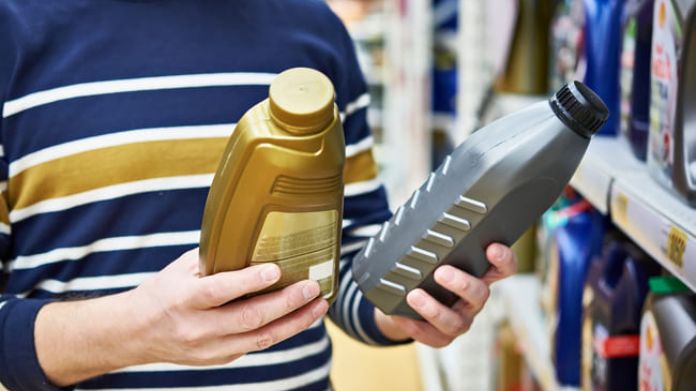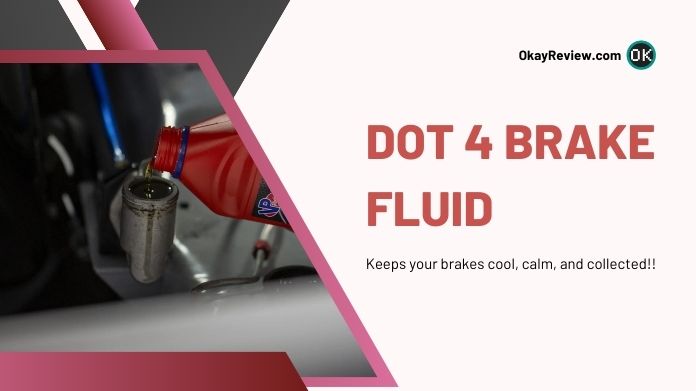Ever pondered the hero behind your ride’s braking prowess? Join us in exploring DOT 4 brake fluid – the secret sauce for smooth brakes and rides. 🚗🔧
This article by Okayreview will highlight the mysterious DOT 4 brake fluid and its twin, DOT 3. What distinguishes them? What difference does it make which one you choose?
Buckle up as we deconstruct the world of brake fluids, investigate the unique characteristics of DOT 4, and compare DOT 3 and DOT 4 brake fluids.
So, whether you’re a curious vehicle owner or a budding auto enthusiast, let’s look at stopping power and fluid dynamics.
Table of Contents
What is Dot 4 Brake Fluid?
DOT 4 brake fluid is a specialized hydraulic fluid used in the braking systems of automobiles, lorries, and motorcycles.
This glycol-based fluid meets severe US Department of Transportation (DOT) criteria and has a higher boiling point than DOT 3 braking fluid – a stunning 230°C (446°F).
DOT 4 fluid provides excellent resistance to corrosion and brake fade caused by moisture and is ideal for high-performance and heavy-duty cars that generate significant braking heat.
Because DOT 4 fluid is less hygroscopic than DOT 3, it holds its quality longer and requires less frequent replacement.
It should be used cautiously since it is unsuitable for some older braking systems and should not be mixed with other types of brake fluid to avoid harmful effects on system performance.
Properties and Benefits of Dot 4 Brake Fluid
The specific qualities of DOT 4 brake fluid lead to improved braking system performance and lifetime.
Here is a closer look at its essential characteristics and the benefits they provide:
1. High Boiling Point
DOT 4 brake fluid has a much higher boiling point than DOT 3 brake fluid. DOT 4 fluid, with a boiling point of around 230°C (446°F), maintains stability under tricky situations such as repeated hard braking or lengthy downhill driving.
This property guarantees the fluid does not vaporize, avoiding air bubbles and ensuring constant brake action.
2. Enhanced Moisture Resistance
One of the most notable characteristics of DOT 4 brake fluid is its capacity to absorb less environmental moisture than DOT 3 brake fluid.
The decreased hygroscopicity increases the fluid’s longevity within the braking system.
Because moisture may damage brake fluid quality and cause corrosion, DOT 4’s improved moisture resistance helps to increase system durability.
3. Resistance to Brake Fade
Brake fade, caused by excessive heat accumulation, can jeopardize braking performance and safety.
The high boiling point of DOT 4 brake fluid reduces the possibility of brake fade, making it an ideal choice for cars carrying big loads, performance-oriented driving, or scenarios generating significant braking heat.
4. Compatibility and Versatility
DOT 4 brake fluid is designed for smooth integration with various braking system elements, including rubber seals, hoses, and metallic parts.
This adaptable composition enables smooth operation throughout various vehicle types, from passenger cars and commercial vehicles to motorbikes, catering to multiple applications.
5. Longevity and Maintenance
DOT 4 brake fluid’s qualities contribute to its long service life. The fluid preserves its integrity for extended periods due to its lower moisture absorption and excellent boiling point, needing fewer fluid refills.
It not only decreases maintenance frequency but also leads to long-term cost savings.
Dot 3 vs. Dot 4 Brake Fluid
 DOT 3 and DOT 4 are brake fluid classifications used in hydraulic braking systems.
DOT 3 and DOT 4 are brake fluid classifications used in hydraulic braking systems.
While they have certain commonalities, they also have significant variances in their chemical makeup, boiling points, and performance qualities.
The following are the essential distinctions between DOT 3 and DOT 4 brake fluid:
1. Boiling Points:
- DOT 3: DOT 3 typically has a lower boiling point as compared to DOT 4, ranging from roughly 401°F to 446°F (205°C to 230°C). It makes it more prone to boiling and vaporizing during severe braking, particularly in challenging conditions.
- DOT 4: Provides a broader range of boiling points, ranging from roughly 446°F to 500°F (230°C to 260°C). Its increased boiling point improves performance under intense heat produced during strong braking, lowering the likelihood of brake fades.
2. Chemical Composition:
- DOT 3: DOT 3 braking fluid, mostly glycol-based, is a hygroscopic polyethylene glycol (PEG) fluid that rapidly absorbs moisture from the surrounding air over time. As water accumulates, this might cause a reduction in its boiling point.
- DOT 4: DOT 4 brake fluid, like DOT 3, is glycol-based, although it frequently adds borate esters to improve its boiling point and overall effectiveness. It is also hygroscopic, meaning that it collects moisture over time.
3. Compatibility:
- DOT 3: DOT 4 fluid is often incompatible with DOT 3 due to variances in chemical composition and performance characteristics.
- DOT 4: In most cars that require DOT 3, DOT 4 may be used interchangeably with DOT 3 fluid. However, studying the owner’s handbook and manufacturer instructions is always good.
4. Performance:
- DOT 3: Suitable for everyday driving conditions and use. It can meet standard braking needs but may struggle in more harsh situations.
- DOT 4: Better performance than DOT 3, especially in high-temperature and heavy-duty braking circumstances. It is usually found in automobiles subjected to extreme driving, towing, or racing.
5. Usage Recommendations:
- DOT 3: DOT 3 brake fluid is suitable for most passenger cars and light trucks equipped with basic braking systems and not subjected to harsh braking conditions.
- DOT 4: Suggested for autos with stringent braking requirements, such as heavy-duty trucks, high-performance vehicles, and those subjected to aggressive driving or repeated high-temperature braking conditions.
Closing Thoughts
So there you have it: DOT 4 brake fluid’s importance and benefits have been exposed!
So, the next time you drive down the highway or push your car to its limits, keep DOT 4 brake fluid in mind.
Stay safe and happy driving! 🚗🚦

